About OHE
Statewide Plan for Higher Education 2004-2012
Regents Priority: Articulation
The Regents ask institutions to describe in their master plans how they will improve articulation between two- and four-year colleges, among public, independent and proprietary colleges and universities, and between undergraduate and graduate programs and institutions to assist students at every level in their progress towards a degree.
Table 2
Full-Time Undergraduates Enrolled at New York Four-Year Institutions Who Transferred from New York Two-Year Institutions Degree and Year Lower
DivisionUpper
DivisionTotal Fall 1999 with Associate Degree 2,020 6,242 8,262 Fall 1999 without a Degree 7,315 3,017 10,332 Fall 1999 Total 9,335 9,259 18,594 Fall 2001 with Associate Degree 2,221 6,044 8,265 Fall 2001 without a Degree 7,825 3,309 11,134 Fall 2001 Total 10,046 9,353 19,399 Fall 2003 with Associate Degree 2,311 5,332 7,643 Fall 2003 without a Degree 7,916 3,690 11,606 Fall 2003 Total 10,227 9,022 19,249 Source: NYSED, Office of Research and Information Systems, 2004 Between the fall of 1999 and the fall of 2001, the number of full-time undergraduates at New York's four-year colleges and universities who transferred from New York two-year colleges grew by 4.3 percent (from 18,594 to 19,399). Between fall 2001 and 2003, the number remained virtually unchanged, declining by 0.8 percent to 19,249. However, many of those students entered the lower division of the four-year institution, reflecting the large number of students who transferred without first attaining an associate degree. The proportion entering the upper division was 49.8 percent in 1999, 48.2 percent in 2001, and 46.9 percent in 2003.
The share of all full-time undergraduates at New York four-year institutions who transferred from New York two-year colleges remained virtually unchanged between 1999 and 2003. In both fall 1999 and fall 2001, it was 4.2 percent. In fall 2003, it had declined to 4.0 percent.
Of particular concern is the declining number and percent of students with associate degrees from New York two-year colleges who transfer to New York four-year colleges and enter the upper division, together with the growing number of associate degree holders transferring into the lower division of four-year colleges. Between 1999 and 2003, the number entering the upper division declined by 14.6 percent, from 6,242 to 5,332. In fall 1999, 75.6 percent of all full-time students transferring to a New York four-year institution with an associate degree from a New York two-year institution entered the upper division. In fall 2001, the proportion declined to 73.1 percent. In fall 2003, it was only 69.8 percent. The data indicate that more effort needs to be made to improve the transfer of students from two-year to four-year colleges in New York State.
Cooperation among institutions is one of the elements of a highly effective higher education system. Where appropriate to their institutional missions, improved educational offerings and services and improved time to degree completion for students may be accomplished by improving articulation between two- and four-year colleges, among all public, independent, and proprietary colleges and universities that are members of The University of the State of New York.
The following describes planning elements that the four sectors, the Board of Regents and the Department will undertake to support the priority of Articulation.
Sector Initiatives in Response to Priority for Articulation
The City University of New York
- Develop additional articulation agreements among and between
community and senior colleges to enhance transfer options,
including the area of teacher education.
- Develop articulation between the school of professional studies and
master's degree programs.
- Complete the implementation of the Internet accessible Transfer Information
and Program Planning System (TIPPS) database that details equivalencies
between courses at different colleges within CUNY, and extend the database
to include courses from non-CUNY institutions.
- Continue to implement the DegreeWorks degree audit system along with
the TreQ transfer articulation system at most colleges. These systems
will provide CUNY students with the ability to audit progress towards
completing their degrees at their current institutions, as well as to
determine the effect of current course and program choices on programs
they may be considering at other institutions.
Independent Colleges and Universities
- Many articulation agreements operate within the independent
sector at all levels.
- To make sure that transfer works the way it should, it must not only
include the admission of transfer students, but that their college credits
earned in academic course are applied to graduation requirements.
- Independent colleges and universities support institution-to-institution
agreements because they provide the flexibility to broker and ensure
effective articulation.
- The relationships that two-year institutions have with four-year institutions
are an essential element in expanding students' horizons to pursue four-year
study.
- The baccalaureate degree is becoming the entry point to the workforce
for the majority of students, making it increasingly important that two-year
to four-year transfer works well.
- To account for academic freedom and institutional diversity, and to
maximize access, articulation agreements must be multi-dimensional and
specifically tailored to the institutions and programs involved.
Proprietary Colleges
Proprietary colleges view articulation from two perspectives, depending in part on the level of their own offerings and the offerings of other colleges. One institution offering both baccalaureate and master's degrees concentrates on pursuing articulation agreements with SUNY and CUNY community colleges to facilitate students' movement to the institution with minimal loss of credit and time. Its admissions counselors do significant outreach with students, informing them about things that will facilitate a successful move to a higher degree program. The goal of one baccalaureate institution with respect to articulation is to have agreements with all community colleges in the State. Another has 34 such agreements. At least two others have or are pursuing articulation agreements with institutions offering M.B.A.s.
- Nearly all associate degree institutions in the sector
have or are seeking articulation agreements with four-year
colleges. Some offer transfer counseling to students considering
pursuit of a baccalaureate degree. At least one maintains
a "transfer resource room" where students can research
information on four-year institutions.
- The most common concern of proprietary colleges accredited by agencies
other than Middle States is that many institutions in the other sectors
do not recognize credit from institutions that do not have regional accreditation,
despite Department urging to the contrary. To deal with that problem,
several two-year colleges are developing courses and reviewing existing
courses to meet local public four-year colleges' requirements. A proprietary
baccalaureate and master's-level institution, with many articulation
agreements with two-year colleges, has observed a local community college
redesign its fine arts curriculum to coincide with its requirements.
State University of New York
- SUNY will continue to encourage the best possible communication
between associate and baccalaureate institutions, with strong
articulation and seamless transfer the desired outcome. Many
campuses have worked particularly hard over the last two
or three years to strengthen articulation agreements and,
more generally, communication with other campuses. SUNY will
continue to enhance campus-to-campus relationships and ensure
that students wishing to transfer receive excellent advisement
and are well prepared for academic work at the receiving
institution.
- SUNY will continue implementation of the Intra-SUNY Transfer Action
Plan, designed to provide seamless and successful transfer for every
SUNY A.A./A.S. graduate to earn a baccalaureate degree with two additional
years of full-time study.
- SUNY's largest transfer initiative, the Teacher Education Transfer
Template (TETT) project, has fostered development of a universal transfer
template in teacher education that has been adopted by 33 associate-degree
campuses and 12 baccalaureate campuses. Working templates - accessible
via the Web - will serve as valuable resources, for students and faculty
alike, supporting advisement and curricular/program development, thereby
facilitating transfer and articulation.
- SUNY will implement phase II of the Community College Strategic Plan,
which is designed to serve as a guide and resource for action as well
as provide measurable outcomes to monitor effectiveness.
Regents Initiatives in Response to Priority for Articulation
Recognition of Transfer Credits
The Department will continue to encourage all institutions to have articulation agreements based on course equivalency that are consistent with their educational missions and that recognize transfer credit fairly and in students' interest.
Jointly Registered Programs
During the period of this Plan, the Department will encourage two-year and four-year colleges to submit applications for registration of joint associate degree-baccalaureate degree programs that provide for a seamless move from the lower to the upper division by students making satisfactory academic progress.
Strengthen the Transferability of Coursework Offered by Two-Year Colleges
Through institutional accreditation and other means, during the period of this Plan the Department will seek to assure that learning objectives for each course are of a level and rigor that warrants acceptance in transfer by other institutions of higher education.
Professional Education Opportunities
See Regents Priority D(10)
Jointly Registered and Articulated Teacher Education Programs between Two- and Four-Year Institutions. See Regents Priority D(11).
Indicators of Progress: Articulation
Change over time in the number of students transferring from two- to four-year colleges in New York State.
- Change over time in the ratio of full-time undergraduate
transfers to the number of full-time undergraduates enrolled
at two-year colleges in the preceding year.
- Change over time in the number of students transferring from associate
degree to baccalaureate teacher education programs under the teacher
education template.
- Change over time in the number of associate degree-baccalaureate degree
programs registered jointly by two-year and four-year colleges.
- Growth in the number of institutions accepting transfer credit from
all institutions accredited by nationally recognized accrediting agencies
rather than only from those that are regionally accredited.
- Develop additional articulation agreements among and between
community and senior colleges to enhance transfer options,
including the area of teacher education.
Regents Priority: Affordability
The Regents will continue to collaborate with higher education institutions to advocate with State and Federal elected officials for an effective fiscal strategy to ensure access and an affordable higher education for all students.
To help make higher education affordable for students and their families, New York funds more student grant aid per student than any other state. For 2000-01 (the most recent year for which all financial aid data are available), New York State provided students $648 million in grants, mostly through the Tuition Assistance Program (TAP). That same year, institutions provided $1.7 billion in institutional grant aid. Including federal grants, grants to students in New York colleges totaled $3.38 billion. However, there also has been a strong reliance on loans to support students' college education. In 2000-01, students at New York colleges received $3.75 billion in loans -- more than 1.1 times the amount of grants. A disproportionate share of loans is made to low- and moderate-income students, an ill-advised approach for a population least able to repay.
A survey of members of the Class of 2005, nationwide, conducted for the Partnership for Public Service, reported that 32 percent of the respondents were "most fearful" of going into debt, 45.1 percent expected to graduate with at least $10,000 of debt and 20.6 percent expected to graduate with more than $20,000 in debt, excluding credit card debt and debt to family members. On the other hand, 27.5 percent reported that they would graduate debt-free.
New York's student aid programs awarded $740 million in need-based aid to eligible undergraduate and graduate students in 2002-03, and $859 million in 2003-04, according to the National Association of State Student Grant and Aid Programs' (NASSGAP) annual survey of states. This was a one-year increase of 7.7 percent, compared to a nationwide increase of less than eight percent. The programs provided nearly 19 percent of all the need-based aid in the nation administered by states in 2003-04. The average need-based aid per undergraduate from New York State was nearly three times the national average of need-based state student aid that year.
As Chart 1 indicates, according to the National Association of State Student Grant and Aid Programs (NASSGAP), in 2002-2003, New York ranked first in the need-based undergraduate grant aid program per full-time equivalent student.
Chart 1
Need-Based Undergraduate Grant Aid per Full-Time Equivalent Enrollment by State: 2003-04
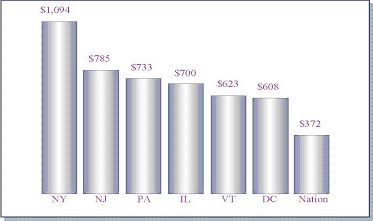
Source: NASSGAP 35th Annual Survey Report on State-Sponsored Student Financial Aid 2003-2004 Academic Year, National Association of State Student Grant and Aid Programs
The value of this aid is demonstrated in an analysis conducted by Postsecondary Education Opportunity of the college participation rate for dependent undergraduates from low-income families for 2002-03. In that analysis, New York State ranked fourth in the nation in the proportion of low-income students participating in higher education.
In the 2003 national study "Standards for What?: The Economic Roots of K-16 Reform," Carnevale and Desrochers state:"But there is also bad news: The absolute levels of bachelor's degree attainment among low-income youth remain low, and the gap in educational performance and access to college have not narrowed in spite of those same policies. Only 36 percent of students from the lowest SES quartile attended a postsecondary institution, while among students in the second and third quartiles, the shares were 53 and 71 percent, respectively. In the top SES quartile, fully 89 percent of the students continued their formal education past high school (Carnevale and Kimmel, forthcoming).
College completion rates for low-income students also are persistently low relative to the completion rates of more affluent students. By age 25, about 42 percent of 16-year-olds from affluent families had earned baccalaureate degrees in the mid-1990's, compared to about 13 percent from low-income families. The odds against bachelor's degree completion for low-income youth are 7-to-1, as opposed to 1.4-to-1 for affluent families (Carnevale, Fry, and Turner, forthcoming)."Affordability appears to be a very important factor in degree attainment.
Between 2000-01 and 2003-04, average tuition and fees for full-time undergraduates at four-year colleges rose by more than 26 percent at SUNY and CUNY (for residents), by 16.5 percent in the independent sector, and by 24.1 percent in the proprietary sector. At two-year colleges, the comparable increases averaged 4.6 percent at SUNY, 22.3 percent at CUNY, 16.0 percent in the independent sector, and 18.6 percent in the proprietary sector. Before the recent public system increases, CUNY's tuition had not changed since 1995.
The data indicate that, since the mid-1970s, New York has been a "high price - high aid" state where public sector tuition charges for State residents that are relatively high as a portion of operating expenditures per student are offset by generous need-based grants to students.( Typically, New York residents from the lowest income category who attend SUNY or CUNY as full-time undergraduates do not pay tuition out-of-pocket. The TAP award meets that cost. As income rises, the amount of the TAP grant decreases, reaching zero at a family income level of $50,000. That level is slightly above the median household income, statewide, which is slightly more than $43,300. Consequently, full-time undergraduate students from most New York families are able to receive some aid from TAP. In 2002-03, the number of annual average undergraduate TAP recipients was 305,300, according to the 2002-03 Annual Report of the New York State Higher Education Assistance Program. That estimate represented 58.1 percent of all full-time undergraduates, statewide, that year who were New York State residents.At SUNY and CUNY four-year and two-year campuses, the maximum TAP award has continued to equal the full-time tuition charged to New York State residents. In 1974, the maximum TAP award covered 60 percent of tuition costs at an independent college. However, the maximum TAP award for students from the lowest income categories (tuition up to $5,000) has not increased since the current award level was phased in for first-time students in 2000-01. At four-year independent institutions the maximum award equaled 30.8 percent of average full-time tuition and fees in 2000-01 and only 26.4 percent in 2003-04. At independent two-year colleges it equaled 61.7 percent of average tuition and fees in 2000-01 and 53.2 percent in 2003-04. At four-year proprietary colleges, the maximum TAP award equaled 44.6 percent of average tuition and fees in 2000-01 and 35.9 percent in 2003-04. At two-year proprietary colleges, the maximum award equaled 54.2 percent of average tuition and fees in 2000-01 and 45.7 percent in 2003-04.
As Chart 2 indicates, New York State had the 4th highest participation rate in the nation for dependent undergraduates from low-income families in 2002-03. Charts 3, 4, 5 and 6 show the effect, over time, of TAP and Pell on the expenses at our public and private colleges for low-income students..
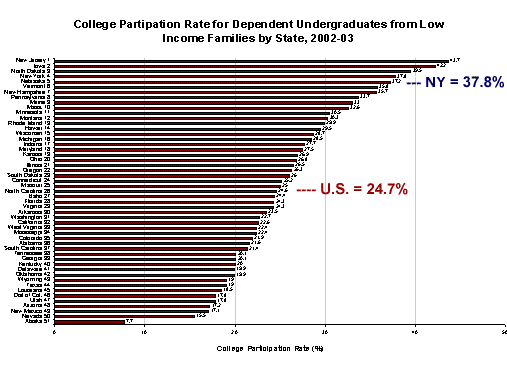
Chart 2
Source: Postsecondary Education Opportunity, Number 150, December 2004, page 3.
Chart 3
TAP and PELL make college possible for New York's neediest students.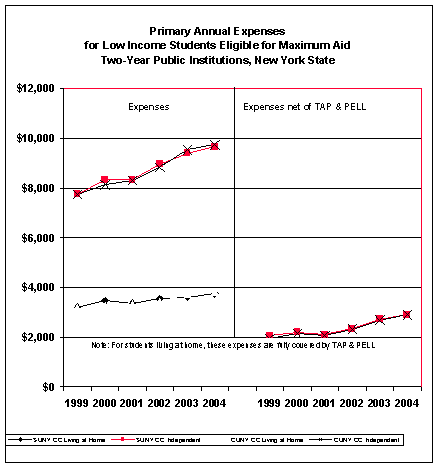
Chart 4
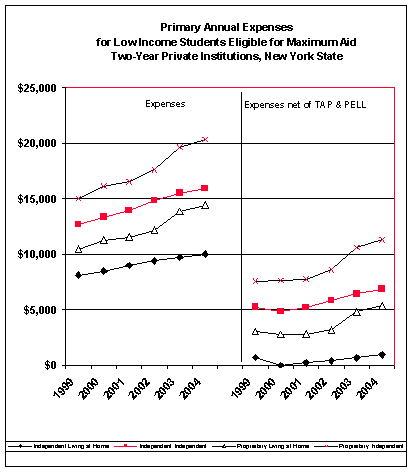
Chart 5
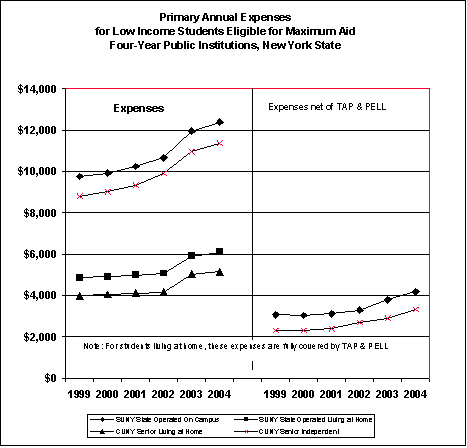
Chart 6
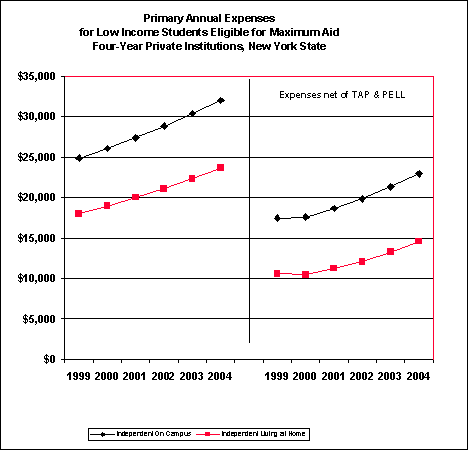
Annual Expenses: Includes tuition, fees, room and board, books, and supplies. No room and board was included for students living at home, but an off-campus room and board amount was included for “independent" (no longer tax dependents of parents) students. Transportation and other living expenses are not included. Data Sources: National Center for Education Statistics, College Board, NYS HEDS data system, Higher Education Services Corporation (federal data), and college publications and websites.
Source: NYSED Office of Research and Information Systems Annual Survey
It is essential that colleges and universities remain affordable for low- and moderate-income students. More needs to be done to reduce student reliance on loans, especially for students in the lowest economic quartile. A top priority for both State and federal agendas should be reaffirming that access to college is a vital component to help ensure success for all.
Accounting for the Use of State Student Aid Funds Student aid comprises about one-quarter of New York State's funding for higher education. For 2004-05, State appropriations for the Tuition Assistance Program and State grant and fellowship programs were about $1 billion. TAP, the largest State program, accounts for about three-quarters of State funding for student grants, scholarships, and fellowships. In 2000-01, however, State funding for student aid comprised less than 20 percent of the $3.38 billion in grants that students at New York colleges and universities received from State, federal, private, and institutional sources.
Even though the State provides a relatively small proportion of total grants, institutions participating in State student aid programs are accountable for their use of State funds. Use of State student aid funds is determined by a participation agreement between each institution and the New York State Higher Education Services Corporation. The Office of the State Comptroller audits public, independent, and proprietary institutions participating in State student aid programs to assure adherence to requirements set in Education Law, the Rules of the Board of Regents, the Regulations of the Commissioner of Education, and the Regulations of the Higher Education Services Corporation. The Comptroller's audits may lead to disallowances for failure to adhere to those requirements, with required repayment of funds. It is important for all institutions participating in State and federal student financial aid programs annually to review their internal controls relating to the certification of student eligibility for these grant awards. This practice will help minimize any potential audit disallowance relating to the use of funds contrary to federal and State regulations.
The following describes planning elements that the four sectors, the Board of Regents and the Department will undertake to support the priority of Affordability.
Sector Initiatives in Response to Priority for Affordability
The City University of New York
- Streamline the financial aid process.
- Provide students with easily accessible information through a
number of innovations: CUNY portal, degree audit software, and the
Enterprise Resource Plan.
Independent Colleges and Universities
- cIcu supports the Regents call for State
funding to ensure access and an affordable
higher education for all students.
- The independent sector has indicated that it will continue to
make full funding of the Tuition Assistance Program (TAP) a top
priority, as it is crucial to providing access. In 1974, the maximum
TAP award covered 60 percent of tuition costs at an independent
college or university; today, it meets less than one-quarter (24
percent) of the independent sector's average weighted tuition.
- The independent sector has been forced to increase institutional
aid, currently at $1.9 billion, to continue its long tradition of
providing access for low- and moderate-income students. Institutional
grants have grown faster than TAP.
- Student borrowing also is increasing as federal and State grant
aid levels remain stagnant. In 2002, the average undergraduate borrowed
$18,900, and the average graduate student $31,700, to fund their
college education, according to Nellie Mae. The increased debt load
discourages many students from attending college and delays post-graduation
decision-making such as home ownership and business start-ups for
others.
Proprietary Colleges
Access at an affordable cost is a major objective of proprietary institutions. With many students coming from lower and middle income families, the availability and adequacy of federal and State student financial assistance, together with scholarship aid, are key factors affecting access. However, three other strategies are crucial in the sector:
- maintain student charges at the lowest level consistent with institutional viability;
- offer education and related services that place graduates in jobs paying enough so that student loans can be repaid in a timely way;
- make available institutional financial assistance. Examples of
the levels and variety of institutional financial aid made available
by proprietary institutions are:
- $12 million by one institution during 2002-03;
- $2.5 million in scholarships and $400,000+ in student wages by another;
- 2.8 percent of tuition revenue by a third;
- a program of one, $1,000 per year merit scholarship at each high school in another college's catchment area;
- policies of not increasing tuition for continuously enrolled students;
- institutional scholarships for veterans and military personnel;
- scholarships for students in the top 25 percent of their high school graduating classes; and
- consideration of student community involvement in awarding scholarships.
Other techniques are:
- zero to moderate annual tuition increases;
- encouraging employer-sponsored tuition reimbursement plans;
- encouraging high schools to offer programs for which college credit can be given, thus reducing students' time in college;
- pre-enrollment financial advice and financial assistance information; and
- creating non-profit foundations to raise scholarship funds.
State University of New York
SUNY is committed to ensuring access and opportunity to the full range of populations served. In meeting its access mission, it is concerned about economic barriers that may prevent a student from attaining a quality higher education in New York. SUNY will continue to seek adequate levels of financial support from federal, State, local, and private sources so that students can stay in school and graduate in a timely manner, consistent with individual educational goals. Mission Review II will see focused attention on the economic diversity of students enrolled.
Regents Initiatives in Response to Priority for Affordability
Student Aid Programs in Title IV of the Federal Higher Education Act
The Regents will advocate with the federal government to:
- strengthen Pell grants, increasing the maximum
grant significantly over the next six years
to help low-income students keep up with rising
costs of attendance, and making other improvements
to increase students' access to higher education;
- maintain both Family Education Loans and Direct Student Loans
and increase the annual and aggregate limits for subsidized loans
for all students;
- raise authorizations for the Leveraging Educational Assistance
Program (LEAP). In New York, LEAP helps fund TAP;
- authorize higher funding levels for the Supplemental Educational Opportunity Grant program, Perkins Loans, and College Work Study to give institutions more resources to use in assisting students to meet the cost of attendance.
Temporary Assistance for Needy Families The Regents will advocate with the federal government for an expanded definition of vocational education to include postsecondary education and to enable recipients of Temporary Assistance for Needy Families to receive more than 12 months of support while enrolled in a higher education program.
Advocacy Plan The Department will take a leadership role in developing a joint advocacy plan for higher education funding that all sectors can support to help ensure that there is appropriate funding for TAP to meet the needs of all our students. In addition, the Plan will support appropriate increases in all of the State's opportunity programs, operating aid for SUNY and CUNY, and moving towards full funding for Bundy Aid.
Accounting for the Use of State Student Aid Funds The Regents urge institutions of higher education participating in State and federal student aid programs to continue to ensure that they comply with relevant statutory and regulatory requirements. The Regents also recommend that all institutions annually review their internal controls relating to the certification of eligibility of its students for State and federal grant aid.
Indicators of Progress: Affordability
- For low- and middle-income students, change
over time in the average undergraduate tuition
and fees net of TAP entitlement, by institutional
type..
- For low- and middle-income students, change over time in the total
price of attending college (i.e., tuition, fees, room and board)
net of TAP and Pell entitlements, by institutional type.
- Change over time in total grant dollars per student, institutional
grant dollars per student, and loan dollars per student, by institutional
type.
- Affordability indicators from the New York State component of
the National Postsecondary Student Aid Study, which will represent
undergraduates at New York's public and independent institutions
(compared to the U.S. and selected other states).
- Comparison of the amount of New York need-based undergraduate
grants to the amount of state-funded, need-based undergraduate grants
offered by key states and nationwide.
- Comparison of the amount of New York need-based undergraduate
grants per full-time equivalent undergraduate to the amount of state-funded,
need-based undergraduate grants per full-time equivalent undergraduate
offered by key states.
- Streamline the financial aid process.
-
Regents Priority: Closing Performance Gaps
The Regents ask institutions to focus in their master plans on student retention and on activities to help close performance gaps based on students' economic status, ethnicity, race or gender.
In the spring 2005 Gallup Youth Survey, youths aged 13 through 17 reported that their top three choices of a career, teacher and physician ranked first, followed by lawyer. Other career fields frequently mentioned included architecture, engineering, nursing, and veterinarian. Achieving these aspirations requires completion of higher education. It is important that we help make aspirations realities for all students, particularly those students who are less likely to graduate and pursue careers in these professions because of icon status, ethnicity, race or gender.
Graduation rates traditionally have been important performance measures for higher education. A growing body of research indicates that there are many complex and interrelated factors associated with the completion of a college degree. In this Plan, we provide information on completion rates specific to New York State and examine some of the factors that may affect completion rates.
As colleges develop initiatives to improve their graduation rates, a key indicator that they monitor is the return of full-time students from their first to their second year. This rate is referred to as the persistence rate. As Chart 7 indicates, New York State students have consistently returned to college from their freshman to sophomore year at a higher rate than the national average (in 2002, 7.3 percent higher for baccalaureate students and 5.9 percent for associate degree students). New York does follow the national trend where persistence for baccalaureate programs is greater than for associate programs.
Chart 7
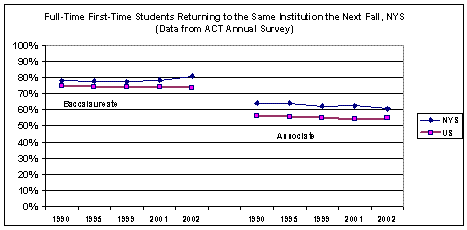
As Chart 8 indicates, the six-year graduation rate for baccalaureate students in New York State is higher for both students graduating from their initial institution and for transfer students. Although not depicted on Chart 8, the Department has projected graduation rates for students beyond six years. It projects that 74.8 percent of the 1997 cohort of students entering baccalaureate programs will complete an associate or baccalaureate degree eventually.
Chart 8

State Sources: NYSED Office of Research and Information Systems Annual Graduation Rate Survey; NYSED Biennial Transfer Enrollment Survey. Federal Source: NCES-IPEDS Federal Graduation Rate Survey
Chart 9 depicts the performance of associate degree students in New York State and the United States. New York's associate degree graduation rate was lower than the national average by 5.5 percent in 2003. Again, extending the time period six years and beyond and including students that transfer into baccalaureate programs without completing an associate degree, it is projected that over 49 percent of students first entering an associate degree program will obtain either an associate or baccalaureate degree eventually.
Chart 9 Upper line in chart (29.1%, 30.6%: NATIONAL graduation rates)
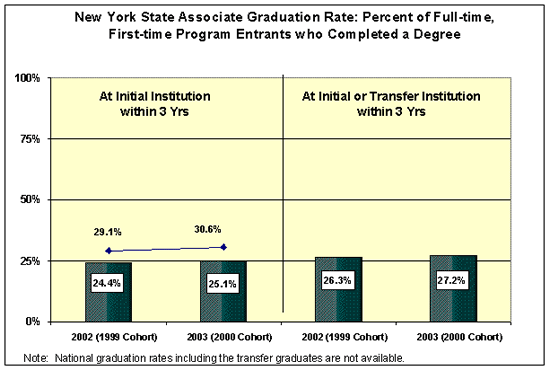
State Source: NYSED Office of Research and Information Systems Annual Graduation Rate Survey; NYSED Transfer Enrollment Survey
Federal Source: NCES-IPEDS Federal Graduation Rate SurveyA national concern relates to the disparity of graduation rates by race and ethnicity. A 2005 report from the Education Trust examines the six-year graduation rates at four-year institutions for students entering in 1997. The study finds significant gaps in the national graduation rate of Black (40.5 percent) and Hispanic (47 percent) students as compared to Asian (65.4 percent) and White (59.5 percent) students.
Chart 10 provides a longitudinal view of the six-year graduation rate for baccalaureate students by race and ethnicity. New York's data mirror the national data with a performance gap by ethnicity. In 2002, White (64.9 percent) and Asian (63.8 percent) students graduated at significantly higher rates than Black (42.5 percent) and Hispanic (43.4 percent) students.
Chart 11 provides comparable graduation rate data for baccalaureate students enrolled in one of the State's opportunity programs (i.e., HEOP, SEEK or EOP). Students in the State's opportunity programs are educationally and economically disadvantaged and many would not otherwise attend college. While the annual graduation rate for opportunity students is lower than for all students, there are some important highlights:- Chart 11 indicates that, for students in opportunity programs, there are similar graduation rates for Black (39.3 percent), Hispanic (38.2 percent) and White (36.6 percent) students and a higher graduation rate for Asian students (49.1 percent).
- Comparing Charts 10 and 11 shows that Black (39.3 percent) and Hispanic (38.2 percent) students in opportunity programs graduate at similar rates as all Black (42.5 percent) and Hispanic (43.4 percent) students.
Chart 10
Academically and educationally disadvantaged Black and Hispanic students in opportunity programs perform almost as well as Black and Hispanic students overall.
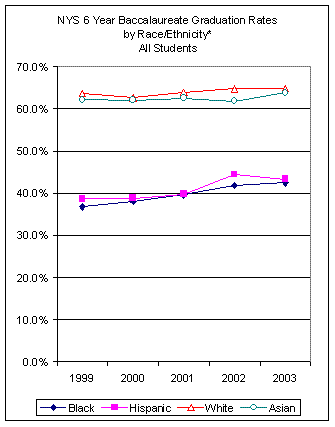
Source: NYSED Office of Research and Information Systems Annual Graduation Rate Survey
Chart 11
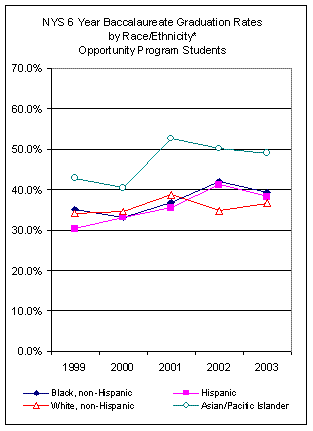
Source: NYSED Office of Research and Information Systems Annual Graduation Rate Survey
Finally, it is important that we continue to work collectively to improve students' time to complete a baccalaureate degree. As indicated on Chart 8, 60.1 percent of New York State students first entering a baccalaureate program in 1997 graduated in six years. Of those students (1997 cohort) who graduated, 74.1 percent graduated within four years. Chart 12 examines the four, five and six year graduation rate by race and ethnicity. It shows that more White and Asian students graduated in four years than Black and Hispanic students. It is important that we work to close performance gaps both in terms of graduation rate and the number of years it takes to graduate.
Chart 12
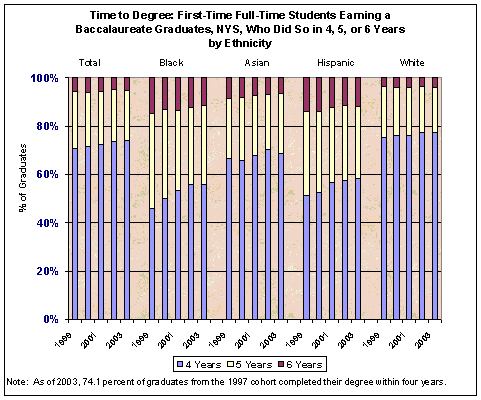
Source: NYSED Office of Research and Information Systems Annual Graduation Rate Survey
This Plan identifies an eight-year approach to address these gaps across all sectors to continue to improve the performance of the higher education system, including:
- continuing to improve the preparation
of all K-12 students to meet higher learning
needs to ensure they are adequately prepared
for postsecondary education;
- focusing on the need to improve the
retention of students from the freshman
to sophomore year;
- supporting initiatives to continue
to close performance gaps in degree attainment
based on ethnicity, race, gender, or
disability; and
- devising programs, initiatives and services to help all students complete their degree programs in a timely manner.
The following describes planning elements that the four sectors, the Board of Regents and the Department will undertake to support the priority of Closing Performance Gaps.
Sector Initiatives in Response to Priority for Closing Performance Gaps
The City University of New York
- CUNY is seeking to identify critical junctures where students are most likely to falter, including entry to college, move from general education to a major or specialization, and transfer between institutions. It sees these as interlocking issues; for example, transfer often entails choosing a new major. It is encouraging both University-wide and college-level strategic planning to take into account these juncture points in students' careers.
CUNY will provide support to retain students:
- continue the University Summer Immersion
Programs to build students' college preparation
in reading, writing, and math;
- continue the summer programs (e.g. ESL, orientation
sessions, math and science bridge courses) to address
particular student needs;
- continue the SEEK and CD programs to provide academic
and counseling support to students;
- offer academic support (i.e., advising and tutoring
programs) to students; and
- identify and apply effective instructional strategies to help under-prepared students realize their academic potential.
Implement programs to help close performance gaps.
- Implement the Chancellor's Initiative on the Black Male
in Education, which seeks to enhance the retention and graduation
of Black men by removing barriers affecting their academic
performance, development of positive relationships, identification
of career goals, employment, and health maintenance. Orientation
courses/seminars will address such issues as course requirements
and career planning as well as social issues relating to
race, gender, and sexuality.
- Continue the English as a Second Language programs to offer support
to English language learners.
- Provide counseling services to special needs students, disadvantaged
students, and students from special programs.
- Develop academic literacy across the curriculum for students through the University-wide Writing Across the Curriculum initiative.
Other services:
- maintain a unified central office for international student
services.
- serve veterans.
Independent Colleges and Universities
- The independent sector will continue to develop programs
to enhance the information skills of all incoming students
based on assessment data results.
- The independent sector will also continue to assess the learning
levels of first-time students to identify individual students and
provide a supplemental program to those who need assistance in academic
or study skills.
- Institutions will make efforts to reach out to non-traditional students
with special programs to help in the overall retention rate of students.
- cIcu and its member institutions will continue to participate in
and advocate for expanded collaborations between secondary schools
and independent colleges, such as GEAR UP and cIcu's Outreach Programs
(Affording College, Your College Search), cIcu periodic Financial
Aid Bulletins, and other programs and activities such as "Camp
College," an early awareness experiential activity hosted on
various campuses for traditionally underrepresented secondary students,
and other programs and publications designed to acquaint secondary
students with the preparation needed for and the opportunities available
in higher education.
Proprietary Colleges
Techniques to close performance gaps are understood and used by most colleges. Of particular interest is the extent to which they have created mechanisms for identifying the recipients of those techniques, and for overseeing, integrating, coordinating and applying them. Techniques reported include such structural arrangements as:
- creating a Retention Committee of institution staff;
- designating a Student Services Coordinator;
- creating an Office of Campus Life;
- having a "diversity expert" on staff; and
- designating an Enrollment Management Committee.
Programmatic approaches include developing a Student Success Pilot Program and creating a Student Success Management Plan.
Techniques used by colleges with formal structural and/or articulated programmatic approaches include:
- new student orientation
- assignment of academic advisors to new students
- new faculty orientation
- faculty development
- mandatory first-year classes in study techniques and resources
- tutorial assistance
- remedial courses and programs
- monitoring student attendance
- student services and organizations
- techniques to identify students in difficulty
Other widely used techniques include:
- maximizing scheduling effectiveness to increase student satisfaction and persistence
- matching students to programs
- using the Noel-Levitz Retention Management System
- scheduled one-on-one faculty assistance for students in academic difficulty
- ESL programs
- significant use of minority faculty
- bilingual tutoring
- use of computerized "learning centers"
- small class size
- on-line tutoring
- regular meetings of each student with campus directors and deans.
Since 2001, the Association of Proprietary Colleges (APC) has been the recipient of GEAR UP (Gaining Early Awareness and Readiness for Undergraduate Programs) grants to help at-risk youths, beginning in the eighth grade, to get ready for college. It has developed workshops targeting parents, teachers, and guidance counselors as well as students. Activities have also included career fairs, financial aid information sessions, admissions conferences, campus visits, computer camps, and remedial math and English classes. APC expects the program to continue at least until 2005, when the original cohort of eighth graders will be applying for college admission.
State University of New York
- SUNY views retention and graduation as important indicators
of academic quality. During the first cycle of Mission
Review, campuses set three- and five-year retention and
graduation rate goals. In Mission Review II, campuses will
update goals and reaffirm commitments to enhance student
success. SUNY will continue to benchmark student outcome
data, including retention and graduation rates, against
appropriate peer institutions.
- Through its Educational Opportunity Program efforts, SUNY will
continue to support students who have the potential to succeed in
higher education despite economic and academic disadvantages, by
providing financial assistance, academic development skills workshops,
advisement, and counseling.
- SUNY works cooperatively with educational sectors throughout the
State to ensure student success at the postsecondary level. It is
an active participant in the statewide GEAR UP project and works
jointly with the Search for Education, Elevation, and Knowledge
(SEEK) program in CUNY.
- Plans for Enhancing Student Outcomes/Success. Successful student
outcomes depend on several factors, including the quality of instruction,
students, and faculty and the quality and availability of student
support services and co-curricular activities. During Mission Review
II, SUNY will seek to better understand the relationship between
these factors and student success at each campus and to facilitate
sharing of best practices. National and system-wide surveys may
be useful in elucidating this relationship. System Administration
will also work with campuses to measure, track, and benchmark postgraduate
success and identify best practices.
Regents Initiatives in Response to Priority for Closing Performance Gaps
Improving Graduation Rates
The research identifies many important initiatives that colleges and universities can take to facilitate on time graduation and/or increase the overall percentage of students who graduate from college. The success of many of these initiatives depends on adequate financial support to institutions and students. Many colleges already have established such initiatives.
Support for Student Retention and Degree Completion. The Board of Regents and the Department will aggressively pursue additional financial support to help colleges improve persistence and completion rates. Colleges and universities should also consider:
- Adopting retention and improvement plans (if they have
not already done so) with concrete goals to be met and
resources to be allocated and assess their activities to
achieve those goals.
- Continuing to increase educational quality and to demand that
students -- especially first-year students -- meet high standards.
- Giving students clear information and advisement on the institution's
expectations of performance in terms of its standards, especially
for first-generation higher education students and students from
at-risk backgrounds or with marginal prior preparation.
- Working with feeder schools to help them meet the Regents goal
that graduating high school seniors are prepared for college
and to assure that middle school and high school pupils have
the information they and their families need concerning academic
demands, costs of attendance, and sources of financial aid. (See
Regents Priority B.7, Information and Assistance in Preparing
for College.)
- Providing academic, financial, social, and personal support
- including faculty, staff, and peer advising; counseling and
mentoring; and other resources - when students need such support
in order to help them stay in college.
- Increasing opportunities for student interactions with students,
faculty, and staff to minimize isolation, particularly in classes
and other student-learning activities, especially for first-generation
college students and those from groups underrepresented in higher
education, from at-risk backgrounds, or with marginal prior preparation.
- Focusing on students newly admitted to the institution to assure
that they are well oriented to its expectations and services,
are able to access academic, social, and personal support, and
interact with their fellow students and with faculty and staff.
- Adopting policies that recognize transfer credit on the basis
of course equivalency to maximize retention of credit transfer
students. (See Regents Priority A.2, Articulation.)
- Using institutional financial aid to encourage full-time attendance
rather than part-time attendance, and to reduce the need to hold
off-campus jobs demanding more than 20 hours of work per week.
Bundy Aid
Aid apportioned on the number of degrees institutions conferred, rather than on enrollment, can serve as an incentive to institutional efforts to assist students to complete their degree programs. Therefore, the Regents recommend a return over time to full funding of Bundy Aid for independent colleges. (See Regents Priority E.13, Funding a Highly Effective System.)
Student Financial Aid
To improve retention and graduation, the Regents will continue to advocate for adequate student grants from the State and federal governments - especially TAP and Pell - to address the financial barriers that low-income students face in seeking to stay in college and earn their degrees. (See Regents Priority A.3, Affordability.)
Higher Education Opportunity Program (HEOP)
The Department will seek to expand HEOP to increase the academic support and supplemental financial assistance for 6,250 FTE students at independent institutions and will support enhancement and expansion of CUNY's SEEK and College Discovery programs and SUNY's Educational Opportunity Program (EOP) to meet identified needs.
Collegiate Science and Technology Entry Program (CSTEP)
By 2008, the Department plans to:
- expand the number of persons served by STEP and CSTEP
from 9,000 to 12,100;
- increase by 148 the number of students from historically underrepresented
minority groups annually enrolling in mathematics, science, and
technology programs;
- increase by 334 the number of baccalaureate degrees in mathematics,
science, and technology fields earned annually by members of
historically underrepresented minority groups.
Minimizing Students' Administrative Burdens
A recent study (Person, Rosenbaum, and Gordon-McKeon, 2004) identified three institutional elements that seem to raise two-year college students' graduation rates:
- "one-stop shopping" for enrollment, registration, and student financial aid;
- predictable and streamlined curricula composed of courses offered in regular sequence; and
- low ratios of counselors to students, enabling counselors to monitor student progress closely.
The Regents urge colleges and universities to take steps to minimize administrative requirements or procedures that may impede student progress and graduation, especially those identified in the Person, Rosenbaum, and Gordon-McKeon study.
Structure of Undergraduate Programs
During the period of this Plan, through accreditation site visits and other regular evaluations of institutions or programs, the Department will review the frequency with which institutions offer the courses in their registered undergraduate programs in order to determine that "courses will be offered with sufficient frequency to enable students to complete the program within the minimum time for completion," as required in §52.2 of the Commissioner's Regulations.
Dissemination of Information on Good Practices
During the period of this Plan, the Department will collect information on good practices supporting student retention and timely completion of programs and disseminate it to all undergraduate institutions. Dissemination may employ such methods as Web pages, publications, conferences, technical assistance, and exchange of information among institutions.
Plans to Improve Retention and Completion
Following review of updated information on retention and completion and the dissemination of information on good practices, the Department will ask undergraduate institutions needing to improve retention, completion, or both to prepare plans to do so and file them with the Department.
Coordination of Efforts
The Department will seek to:
- enhance coordination of efforts by Liberty Partnerships,
STEP, CSTEP, the Empire Promise Nurse Opportunity Corps,
and opportunity programs to maximize the benefit to middle
and high school pupils and to undergraduates.
- encourage coordination in New York City between STEP programs
and CUNY's College Now programs to maximize their benefits to
pupils.
Additional Initiatives to Close the Gap and Improve Graduation Rates.
The Regents endorse the following additional initiatives both to close the gap and to improve graduation rates, overall, and encourage institutions to consider employing them to improve retention and completion. They include:
- Writing Across the Curriculum and similar programs to
enhance students' academic literacy and skill at writing
college-level prose.
- Information literacy efforts to assure that students understand
how to conduct research and to locate and evaluate information.
- The Chancellor's Initiative on the Black Male in Education,
as set forth in the CUNY Master Plan, which seeks to enhance
the retention and graduation of Black men by removing barriers
affecting their academic performance, development of positive
relationships, identification of career goals, employment, and
health maintenance.
- Techniques identified by the federally funded Model Institutions
for Excellence, at the 2005 annual meeting of the American Educational
Research Association, as enhancing students' ability to succeed
include:
- Identifying students who are having trouble following major examinations in their first term and offering them intensive counseling and tutoring;
- Intensive discussion sessions for students in "make-or-break" introductory courses, especially in the sciences;
- Summer programs for entering freshmen and returning sophomores to enhance their skills; and
- Expanded opportunities for undergraduate participation in
research and similar scholarly endeavors and to familiarize
themselves with opportunities for graduate study.
Opportunities in Nursing
See Regents Priority D(10).
Indicators of Progress: Closing Performance Gaps
- Persistence rates from first to second year, statewide,
for all undergraduates, by racial/ethnic category, and
by regular and opportunity program admission.
- Graduation rates, statewide, for all undergraduates, by racial/ethnic
category, and by regular and opportunity program admission.
- Length of time to degree, statewide, for all undergraduates,
by racial/ethnic category, and by regular and opportunity program
admission.
-
Regents Priority: Students with Disabilities
The Regents ask institutions to focus in their master plans on access and success for their students who have disabilities. The Regents will work with the higher education community to assure that institutions have adequate financial support to maintain and initiate appropriate programs and services for these students.
According to data from the high school graduating Class of 2001, one year after school exit, the 38 percent rate of transition to two- or four-year colleges for former special education pupils is dramatically higher than was the 17 percent rate for the Class of 1996. However, gaps continue to exist between the college participation of general and special education pupils (80.5 percent compared to 37.8 percent). Significantly more pupils with disabilities planned to attend college in 2003 (49 percent).
Chart 13
Enrollment of Students with Disabilities in Higher Education
New York State, Fall 1993 to Fall 2003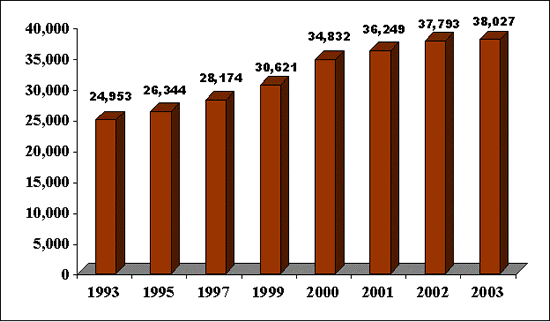
Over the last ten years, the number of persons with self-identified disabilities attending college grew by 52.4 percent, from 24,953 in the fall of 1993 to 38,027 in the fall of 2003, when they were 3.4 percent of all students enrolled. Increasing numbers of students with disabilities will be graduating from high school with the desire to pursue higher education. These students offer special challenges for higher education. Faculty training, assistive technology, counseling, and appropriate support personnel are some of the factors being addressed by colleges and universities. Accessibility and success for students with disabilities in higher education will depend on an understanding of how to provide needed services effectively to these students and the ability to provide them. When given appropriate support, students with disabilities perform at rates equivalent to all students. For example, 60.2 percent of all full-time, first-time students matriculating in baccalaureate programs in the fall of 1997 earned baccalaureate degrees from the same institution by August 31, 2003; the rate for students with self-identified disabilities was 62.9 percent.
The following describes planning elements that the four sectors, the Board of Regents and the Department will undertake to support the priority of Students with Disabilities.
Sector Initiatives in Response to Priority for Students with Disabilities
The City University of New York
CUNY's current enrollment of over 8,000 self-identified students with disabilities reflects a significant increase in this rapidly growing CUNY population. Meeting their diverse academic and social needs by providing and maintaining high quality innovative programs, technical assistance in the classroom, transportation to classes and extracurricular activities, and CUNY-wide campus access gives students with disabilities an equal opportunity to receive a high quality, affordable college education based on individual scholastic achievements and merit.
The University intends to implement, to the degree possible, the following recommendations of a University Faculty Senate focus group:
- using the CUNY Portal, establish a disability Web site
that includes a disability handbook to serve as a resource
guide for faculty/staff and provide access to pertinent
information for all students;
- assess the feasibility of establishing regional resource centers
for learning disabilities and identify cost-effective strategies
for their implementation;
- during CUNY disability month, conduct a University-wide conference
for faculty, campus administrators, staff, and security personnel
on appropriate techniques for teaching and providing assistance
to students with disabilities;
- develop a marketing video in conjunction with CUNY TV for use
by disability coordinators and admissions offices;
- augment the availability of College Now programs and opportunities
for high school students with disabilities;
- expand the provisions of the New York Community Trust Transportation
Grant to facilitate the participation of students with disabilities
in campus student life;
- develop a plan to provide centralized coordination for interpreter
services, to reduce costs and provide expertise in selecting
and maintaining quality service;
- enhance academic accommodations for students with disabilities
by providing faculty training in handling sensitivity issues
and providing technical assistance in the classroom when administering
exams and in teacher/student conferences;
- ensure that all CUNY standardized examinations are fully accessible;
- train faculty and instructors in making online instruction
accessible to students with disabilities;
- ensure that students with disabilities are represented on committees
that develop technology plans on campuses and that college technology
fees accommodate needs to purchase technology for students with
disabilities;
- ensure integration of disabled students into positions outside
campus disability offices, including student aides and assistants;
and
- develop an education program on ADA compliance modeled on CUNY's
sexual harassment education program.
Independent Colleges and Universities
- So that disabilities do not hinder students from achieving
their academic goals, the independent sector supports programs
of planning, insight, self-advocacy, and accommodation.
- To assist students with learning disabilities, independent
colleges and universities sponsor programs to maximize students'
potential. These programs focus on planning, insight, advocacy
and accommodation. Institutional strategic plans differentiate
between modifications (i.e., lowering standards and expectations)
and accommodations that equalize the playing field through sensitivity
to time and environmental constraints.
- Because college students with disabilities have diverse needs,
unique modifications are often needed, what may work as an accommodation
for one person may not be useful for another, but may prove to
be a barrier to learning. Thus, to truly assist students with
learning disabilities, independent colleges and universities
sponsor programs to maximize students' potential in the college
setting.
- To accomplish its goal for students with disabilities, the
independent sector reaffirms its ongoing commitment to quality
improvement and high performance for all students.
- The independent sector recommends that the Regents and the
State Education Department continue to endorse their priority
of securing additional State and federal funding to enhance campus
efforts for students with disabilities.
Proprietary Colleges
Most colleges use a variety of initiatives to assist students with disabilities that go well beyond reasonable accommodation. They range from:
- encouraging students to disclose disabilities to facilitate
maximum support through:
- employment of learning disabilities specialists
- faculty and staff training that addresses common perceptions and misperceptions about individuals with disabilities
- training faculty to identify learning disabilities and encouraging them to bring to the attention of a designated staff member any student appearing to have a disability
- outreach programs for high school students with disabilities
- peer mentoring
- special tutoring
- the use of study aides
- school-supervised internships.
- to such structural arrangements as:
- designation of a Disabled Student Coordinator;
- formation of an internal Committee on Disabilities;
- provision of Learning Centers; and
- working closely with VESID.
Every college provides equipment to accommodate physical disabilities and special materials, equipment, and software needed by students with disabilities; and assures accessibility to the campus.
State University of New York
SUNY's enrollment of students with disabilities (18,027 in 2003-04) has increased nearly fourfold over the last two decades, and is up 30 percent since 1995. The SUNY Master Plan indicates that the enrollment of students with disabilities will continue to be a priority during Mission Review II.
- In conjunction with the ongoing work of SUNY's Office
of Disabilities and Information and local campus support
services, assuring compliance with the Rehabilitation Act
of 1973, Section 504 and the Americans with Disabilities
Act of 1990, a systemwide committee has been established
to address ongoing issues and plans related to students
with disabilities.
- SUNY will continue to work with SED and the sectors on the
statewide initiatives of postsecondary education and students
with disabilities.
Regents Initiatives in Response to Priority for Students with Disabilities
Transition Activities
Data inform the decision making process and support local, regional and statewide plans for improvement. To further increase participation in career planning, in the coming year school report cards will report data on Career Plan participation for general and special education pupils in grades 4-12. The Career Plan serves as a document for learners to record their development in the areas of self-knowledge, career exploration, career and life goals, classroom learning application, and foundation skill awareness.
Technical assistance around the transition to the postsecondary setting is provided to students, families, schools, and postsecondary institutions.
- In an effort to focus on system changes and continue
to improve postsecondary outcomes for students with disabilities,
the Department will continue to fund the Transition Coordination
Sites (TCS), a regionally based technical assistance network
of seven sites supporting local and statewide implementation
of the Regents long-term goal of preparing students with
disabilities for living, learning, and working in the community
as adults. Each site works closely with schools, students,
families, and higher education institutions to facilitate
a smooth transition to college.
- With the release of a new Request for Proposal for continuation
of the TCS network, the Department is committed to providing
technical assistance around transition issues for the next five
years.
- The Department's Transition Web site provides much information
about the transition to postsecondary education for students
with disabilities. Effective practices are in the process of
being collected, as are resources for a transition toolbox. Both
will be posted on the Web in the coming year.
Transition Needs Assessment
To increase the consistency of school district implementation of planning and services, a transition needs assessment rubric is being designed. The goal is to develop a skill-based tool to assist in building pupil capacity for transition to employment, postsecondary education, and community living.
Postsecondary Activities
Higher Education Faculty Development
The Department is developing a "Higher Education Faculty Development" Request for Proposal. It will allow for the establishment of a statewide demonstration project to (1) provide knowledge and training for college faculty in the use of assistive technology and modification of existing or new curricula to be more universally adaptable; (2) develop a model mentoring program involving college and secondary students, faculty, and staff; and (3) provide professional development and training to other higher education institutions for the purpose of replication of the model.
Chapter 219 of the Laws of 2003
was enacted to improve access to instructional materials for college students with a print disability. Publishers and manufacturers of instructional material essential to a student's success in a college course will make material available in alternate format in a timely manner. The Department engaged an advisory group, including publishers, college disability service coordinators, students with disabilities, representatives from Recordings for the Blind & Dyslexic, the Commission for the Blind and Visually Handicapped, and the American Association of Publishers, to assist in developing a field memo for implementation of Chapter 219.
Readers Aid Program
New Yorkers who are deaf, deaf and blind, or blind, and who are matriculated in a degree-granting institution, may apply for funds to help pay the costs of readers, notetakers, and interpreters to provide access to information vital to their studies. The Department is working with the Commission for the Blind and Visually Handicapped and institutions of higher education to analyze data for justification to increase the funding for this program.
Disability Services
- The Department has been increasing efforts to involve the college disability service coordinators in activities that impact higher education (i.e. Chapter 219, vocational rehabilitation college policy, legislative funding proposal).
- The Department will develop a Web-based statewide Disability
Service Directory that will enable a student or parent
to learn what services are available for students with
disabilities at any college in the State and be provided
with contact information.
- The Department is finalizing an RFP for eligible candidates
to provide sign language interpreting services to VESID consumers
as part of their reasonable accommodations in a postsecondary
training experience.
Regents Priority Legislation
In collaboration with SUNY, CUNY, independent institutions, and proprietary colleges, the Department has submitted a legislative proposal requesting $15 million to assist public, independent, and proprietary colleges and universities in meeting the needs of students with self-identified disabilities by:
- providing base support for capacity building by individual institutions;
- supporting the development of institutional programmatic activities; and
- supporting programs that establish targets for recruiting students
with disabilities.
Indicators of Progress: Students with Disabilities
- Change over time in enrollment, statewide and by sector, of students self-reporting disabilities.
- Students with self-reported disabilities transferring from two-year to four-year institutions, statewide.
- Graduation rates of students with self-reported disabilities, statewide and by sector.
- Availability of college textbooks and related material in alternate formats for students with disabilities.
- Implementation of the "Higher Education Faculty Development" Request for Proposal.
- New York State Longitudinal Post School Indicator Study results.
- Change over time in the number of high school pupils with disabilities served, statewide, by the Transition Coordination Sites.
- Success of Regents Priority legislative proposal to provide funds to colleges to improve services for students with disabilities.
- using the CUNY Portal, establish a disability Web site
that includes a disability handbook to serve as a resource
guide for faculty/staff and provide access to pertinent
information for all students;
